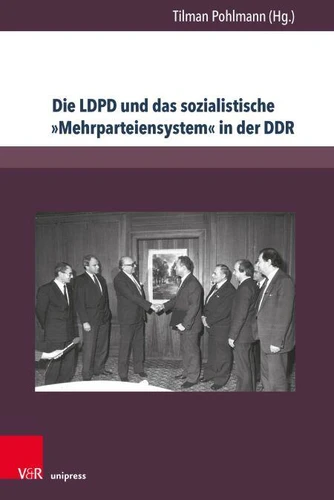Die LDPD und das sozialistische »Mehrparteiensystem« in der DDR
Par : , , , ,Formats :
Disponible dans votre compte client Decitre ou Furet du Nord dès validation de votre commande. Le format PDF est :
- Compatible avec une lecture sur My Vivlio (smartphone, tablette, ordinateur)
- Compatible avec une lecture sur liseuses Vivlio
- Pour les liseuses autres que Vivlio, vous devez utiliser le logiciel Adobe Digital Edition. Non compatible avec la lecture sur les liseuses Kindle, Remarkable et Sony
 , qui est-ce ?
, qui est-ce ?Notre partenaire de plateforme de lecture numérique où vous retrouverez l'ensemble de vos ebooks gratuitement
Pour en savoir plus sur nos ebooks, consultez notre aide en ligne ici
- Nombre de pages242
- FormatPDF
- ISBN978-3-8470-1003-6
- EAN9783847010036
- Date de parution05/10/2020
- Protection num.pas de protection
- Taille3 Mo
- Infos supplémentairespdf
- ÉditeurV&R Unipress
Résumé
Gegenstand dieses Bandes sind Strukturen, Figuren, Handlungs- und Denkmuster, die im sozialistischen »Mehrparteiensystem« der DDR von wesentlicher Bedeutung für deren Stabilität und Legitimation waren. Die SED inszenierte das Konstrukt vermeintlicher Parteipluralität in der DDR, um nach außen ihre Hegemonie zu verhüllen und nach innen gesellschaftspolitische Kräfte einzubinden, die für sie selbst kaum zugänglich waren.
Doch darin ging die Bedeutung der »sozialistischen Bündnispolitik« keineswegs auf. Die Autoren nähern sich dieser Thematik mit verschiedenen Forschungsansätzen und -gegenständen. Dabei liegt ein Schwerpunkt auf der Untersuchung der Liberaldemokratischen Partei Deutschlands (LDPD), für die bislang kaum fundierte Studien vorliegen. Subject of this volume are structures, figures, patterns of action and thought, which were of essential importance for the stability and legitimacy in the socialist "multiparty system" of the GDR.
The SED staged the construct of alleged party pluralism in the GDR in order to cloak its hegemony to the outside and to integrate socio-political forces inwardly, which were hardly accessible to them. But this was not the only importance of the "socialist alliance policy". The autors approach the topic with various research approaches and objects. One focus is on the study of the Liberal Democratic Party of Germany (LDPD), for which hardly any well-founded studies are available so far.
Doch darin ging die Bedeutung der »sozialistischen Bündnispolitik« keineswegs auf. Die Autoren nähern sich dieser Thematik mit verschiedenen Forschungsansätzen und -gegenständen. Dabei liegt ein Schwerpunkt auf der Untersuchung der Liberaldemokratischen Partei Deutschlands (LDPD), für die bislang kaum fundierte Studien vorliegen. Subject of this volume are structures, figures, patterns of action and thought, which were of essential importance for the stability and legitimacy in the socialist "multiparty system" of the GDR.
The SED staged the construct of alleged party pluralism in the GDR in order to cloak its hegemony to the outside and to integrate socio-political forces inwardly, which were hardly accessible to them. But this was not the only importance of the "socialist alliance policy". The autors approach the topic with various research approaches and objects. One focus is on the study of the Liberal Democratic Party of Germany (LDPD), for which hardly any well-founded studies are available so far.
Gegenstand dieses Bandes sind Strukturen, Figuren, Handlungs- und Denkmuster, die im sozialistischen »Mehrparteiensystem« der DDR von wesentlicher Bedeutung für deren Stabilität und Legitimation waren. Die SED inszenierte das Konstrukt vermeintlicher Parteipluralität in der DDR, um nach außen ihre Hegemonie zu verhüllen und nach innen gesellschaftspolitische Kräfte einzubinden, die für sie selbst kaum zugänglich waren.
Doch darin ging die Bedeutung der »sozialistischen Bündnispolitik« keineswegs auf. Die Autoren nähern sich dieser Thematik mit verschiedenen Forschungsansätzen und -gegenständen. Dabei liegt ein Schwerpunkt auf der Untersuchung der Liberaldemokratischen Partei Deutschlands (LDPD), für die bislang kaum fundierte Studien vorliegen. Subject of this volume are structures, figures, patterns of action and thought, which were of essential importance for the stability and legitimacy in the socialist "multiparty system" of the GDR.
The SED staged the construct of alleged party pluralism in the GDR in order to cloak its hegemony to the outside and to integrate socio-political forces inwardly, which were hardly accessible to them. But this was not the only importance of the "socialist alliance policy". The autors approach the topic with various research approaches and objects. One focus is on the study of the Liberal Democratic Party of Germany (LDPD), for which hardly any well-founded studies are available so far.
Doch darin ging die Bedeutung der »sozialistischen Bündnispolitik« keineswegs auf. Die Autoren nähern sich dieser Thematik mit verschiedenen Forschungsansätzen und -gegenständen. Dabei liegt ein Schwerpunkt auf der Untersuchung der Liberaldemokratischen Partei Deutschlands (LDPD), für die bislang kaum fundierte Studien vorliegen. Subject of this volume are structures, figures, patterns of action and thought, which were of essential importance for the stability and legitimacy in the socialist "multiparty system" of the GDR.
The SED staged the construct of alleged party pluralism in the GDR in order to cloak its hegemony to the outside and to integrate socio-political forces inwardly, which were hardly accessible to them. But this was not the only importance of the "socialist alliance policy". The autors approach the topic with various research approaches and objects. One focus is on the study of the Liberal Democratic Party of Germany (LDPD), for which hardly any well-founded studies are available so far.




